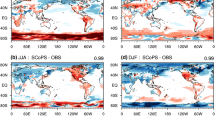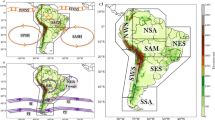Abstract
We have quantified and examined the South Pacific convergence zone (SPCZ) characteristics for the purpose of its seasonal prediction, by defining two orientation indices, strength and area. The multi-model ensemble (MME) tends to simulate the ENSO-associated shift of SPCZ orientation, especially for the 1-month forecast lead. The migration of the SPCZ orientation indices associated with ENSO phases is clear in the observation and the MME. The variation of the SPCZ strength and area associated with ENSO phases is not as clear as in the SPCZ orientation. In spite of marginal changes in the SPCZ strength and area related to ENSO phases, the SPCZ strength becomes a bit stronger during El Niño and weaker during La Niña, which is represented in individual models and MME. The performance of the MME in simulating the variability of the SPCZ orientation, strength and area is also examined. We found that the MME reasonably predicts the observed interannual variability of the western portion of the SPCZ, with systematic and marginal shift southward. Compared to the western part of the SPCZ, the MME seems to have a limitation in predicting the variability of the eastern part. In comparison to the SPCZ orientation, the MME is not capable of predicting the strength and area of the SPCZ. The interannual variability of the SPCZ strength in the MME is systematically weaker compared to that in the analysis. By comparison with SPCZ orientation and strength, the SPCZ area is not resolved in the MME. The SPCZ is a main source of precipitation in the South Pacific, and the SPCZ predictability also influences high impact weather prediction such as tropical cyclones. Therefore, skillful predictions of seasonal variability of the SPCZ could benefit users who utilize the seasonal forecasting information for their decision making in many applicable sectors.








Similar content being viewed by others
References
Adler RF, Huffman GJ, Chang A, Ferraro R, Xie P, Janowiak J, Rudolf B, Schneider U, Curtis S, Bolvin D, Gruber A, Susskind J, Arkin P, Nelkin E (2003) The version 2 Global Precipitation Climatology Project (GPCP) monthly precipitation analysis (1979-present). J Hydrometeor 4(6):1147–1167
Ahn JB, Kim HJ (2013) Improvement of one-month lead predictability of the wintertime AO using a realistically varying solar constant for a CGCM. Meteorol Appl 21:415–418. doi:10.1002/met.1372
Barry RG, Chorley RJ (2003) Atmosphere, weather and climate. 8th edn. Routledge, p 421
Borlace SA, Santoso A, Cai W, Collins M (2014) Extreme swings of the South Pacific Convergence Zone and the different types of El Niño events. Geophys Res Lett 41:4695–4703. doi:10.1002/2014GL060551
Cai W, Lengaigne M, Borlace S, Collins M, Cowan T, McPhaden MJ, Timmermann A, Power S, Borwn J, Menkes C, Ngari A, Vincent EM, Widlansky MJ (2012) More extreme swings of the South Pacific convergence zone due to greenhouse warming. Nature 488:365–369
Charles AN, JR Brown, A Cottrill, KL Shelton, T Nakaegawa, Y Kuleshov (2014) Seasonal prediction of the South Pacific Convergence Zone in the aus-tral wet season, J Geophys Res Atmos 119:12,546–12,557, doi:10.1002/2014JD021756
Chung CTY, Power SB, Arblaster JM, Rashid H, Roff GL (2013) Nonlinear precipitation response to El Niño and global warming in the Indo-Pacific. Clim Dyn. doi:10.1007/s00382-013-1892-8
DelSole T, Nattala J, Tippett MK (2014) Skill improvement from increased ensemble size and model diversity. Geophys Res Lett. doi:10.1002/2014GL060133
Folland CK, Renwick JA, Salinger MJ, Mullan AB (2002) Relative influences of the Interdecadal Pacific Oscillation and ENSO on the South Pacific Convergence Zone. Geophys Res Lett 29:21-1-21-4. doi:10.1029/2001GL014201
Goddard L, Mason S (2002) Sensitivity of seasonal climate forecasts to persisted SST anomalies. Clim Dyn 19:619–632
Haffke C, Magnusdottir G (2013) The South Pacific Convergence Zone in three decades of satellite images. J Geophys Res Atmos 118:10,839–10,849. doi:10.1002/jgrd.50838
Hagedorn R, Doblas-Reyes F, Palmer RN (2005) The rationale behind the success of multimodel ensembles in seasonal forecasting—I. Basic concept. Tellus 57A:219–233
Hwant YT, Frierson DMW (2013) Link between the double-Intertropical Convergence Zone problem and cloud bias over Southern Ocean. PNAS 110(13), doi:10.1073/pnas.1213302110
Jeong HK, Lee DY, Ashok K, Ahn JB, Lee JY, Luo JJ, Schemm JK, Hendon HH, Braganza K, Ham YG (2012) Assessment of the APCC coupled MME suite in predicting the distinctive climate impacts of two flavors of ENSO during boreal winter. Clim Dyn 39:475–493
Kidwell A, Lee T, Jo YH, Yan XH (2016) Characterization of the variability of the South Pacific Convergence Zone using satellite and reanalysis wind products. J Clim 29:1717–1732
Kiladis GN, Storch HV, Loon HV (1989) Origin of the South Pacific Convergence Zone. J Clim 2:1185–1195
Kim OY, Chan JCL (2017) Cyclone-track based seasonal prediction for South Pacific tropical cyclone activity using APCC multi-model ensemble prediction (under review)
Kim OY, Kim HM, Lee MI, Min YM (2017) Dynamical-statistical seasonal prediction for western North Pacific typhoons based on APCC multi-models. Clim Dyn 48:71–88. doi:10.1007/s00382-016-3063-1
Kirtman BP, Min D (2009) Multimodel ensemble ENSO prediction with CCSM and CFS. Mon Wea Rev 137:2908–2930
Li S, Goddard L, Dewitt DG (2008) Predictive skill of AGCM seasonal climate forecasts subject to different SST prediction methodologies. J Clim 21:2169–2186
Lim EP, Hendon HH, Langford S, Alves O (2012) Improvements in POAMA2 for the prediction of major climate drivers and south eastern Australian rainfall. CAWCR Tech. Rep. No. 051. http://www.cawcr.gov.au/publications/technicalreports.php
Lin JL (2007) The double-ITCZ problem in IPCC AR4 coupled GCMs: Ocean-atmosphere feedback analysis. J Clim 20:4497–4525
Lintner BR, Neelin JD (2008) Eastern margin variability of the South Pacific Convergence Zone. Geophys Res Lett 35:L16701. doi:10.1029/2008GR034298
Matthews AJ (2012) A multiscale framework for the origin and variability of the South Pacific Convergence Zone. Q J R Meteorol Soc 138:1165–1178
Merryfield WJ et al (2013) The Canadian seasonal to interannual prediction system. Part I: models and initialization. Mon Weather Rev 141:2910–2945. doi:10.1175/MWR-D-12-00216.1
Min YM, VN Kryjov, SM Oh (2014) Assessment of APCC multimodel ensemble prediction in seasonal climate forecasting: Retrospective (1983–2003) and real-time forecasts (2008–2013). J Geophys Res Atmos 119:12,132–12,150. doi:10.1002/2014JD022230
Min YM, Kryjov VN, Oh SM, Lee HJ (2017) Skill of real-time operational forecasts with the APCC multi-model ensemble prediction system during the period 2008–2015. Clim Dyn, doi:10.1007/s00382-017-3576-2 (online published)
Molod A et al (2012) The GEOS-5 atmospheric general circulation model: mean climate and development from MERRA to Fortuna. Technical Report Series on Global Modeling and Data Assimilation, 28. http://gmao.gsfc.nasa.gov/pubs/docs/tm28.pdf
Palmer T, Alessandri A, Andersen U, Cantelaube P, Davey M, Delecluse P, Deque M, Diez E, Doblas-Reyes FJ, Graham HFR, Gualdi S, Gueremy JF, Hagendorn R, Hoshen M, Keenlyside N, Latif M, Lazar A, Maisonnave E, Marletto V, Morse AP, Orfila B, Rogel P, TErres JM, Thomson MC (2004) Development of a European multimodel ensemble system for seasonal-to-interannual prediction (DEMETER). Bull Am Meteor Soc 85:853–872
Reynolds RW, Rayner NA, Smith TM, Stokes DC, Wang W (2002) An improved in situ and satellite SST analysis for climate. J Clim 15:1609–1625
Saha S, Moorthi S, Wu X, Wang J, Nadiga S, Tripp P, Behringer D, Hou Y-T, Chuang H-Y, Iredell M, Ek M, Meng J, Yang R, Mendez MP, van den Dool H, Zhang Q, Wang W, Chen M, Becker E (2014) The NCEP climate forecast system version 2. J Clim 27:2185–2208. doi:10.1175/JCLI-D-12-00823.1
Salinger MJ, McGree S, Beucher F, Power SB, Delage F (2014) A new index for variations in the position of the South Pacific convergence zone 1910/11–2011/2012. Clim Dyn 43:881. doi:10.1007/s00382-013-2035-y
Vincent DF (1994) The south Pacific convergence zone (SPCZ): a review. Mon Wea Rev 122:1949–1970
Vincent EM, Lengaigne M, Menkes CE, Jourdain NC, Marchesiello P, Madec G (2011) Interannual variability of the South Pacific Convergence Zone and implications for tropical cyclone genesis. Clim Dyn 36:1881–1896
Wang B, Lee JY, Kang IS, Shukula J, Park CK, Kumar A, Scheme J, Cocke S, Kug JS, Luo JJ, Zhou T, Wang B, Fu X, Yun WT, Alves O, Jin EK, Kinter J, Kirtman B, Krishnamurti T, Lau NC, Lau W, Liu P, Pegion P, Rosati T, Schubert S, Stern W, Suarez M, Yamagata T (2009) Advance and prospectus of seasonal prediction: assessment of the APCC/CliPAS 14-model ensemble retrospective seasonal prediction (1984–2004). Clim Dyn 33:93–117
Weigel AP, Liniger MA, Appenzeller C (2008) Can multi-model combination really enhance the prediction skill of probabilistic ensemble forecast? Q J R Meteorol Soc 134:241–260
Widlansky MJ, Webster PJ, Hoyos CD (2011) On the location and orientation of the South Pacific Convergence Zone. Clim Dyn 36:561–578
Xie P, Arkin PA (1997) Global precipitation: a 17-year monthly analysis based on gauge observations, satellite estimates, and numerical model outputs. Bull Am Meteor Soc 78:2539–2558
Yang D, Yang XO, Xie Q, Zhang Y, Ren X, Tang Y (2016) Probabilistic versus deterministic skill in predicting the western North Pacific-East Asian summer monsoon variability with multimodel ensembels. J Geophys Res 121:1079–1103
Zhang C (2001) Double ITCZs, J Geophys Res 106:11,787–11,792
Acknowledgements
This research was supported by the APEC Climate Center. The authors are very grateful to the APEC MME Producing Centers for making their handcast/forecast data available for analysis and the APEC Climate Center for collecting and archiving them and for organizing APCC MME prediction.
Author information
Authors and Affiliations
Corresponding author
Rights and permissions
About this article
Cite this article
Kim, OY. Assessment of seasonal prediction of South Pacific Convergence Zone using APCC multi-model ensembles. Clim Dyn 50, 3237–3250 (2018). https://doi.org/10.1007/s00382-017-3802-y
Received:
Accepted:
Published:
Issue Date:
DOI: https://doi.org/10.1007/s00382-017-3802-y




